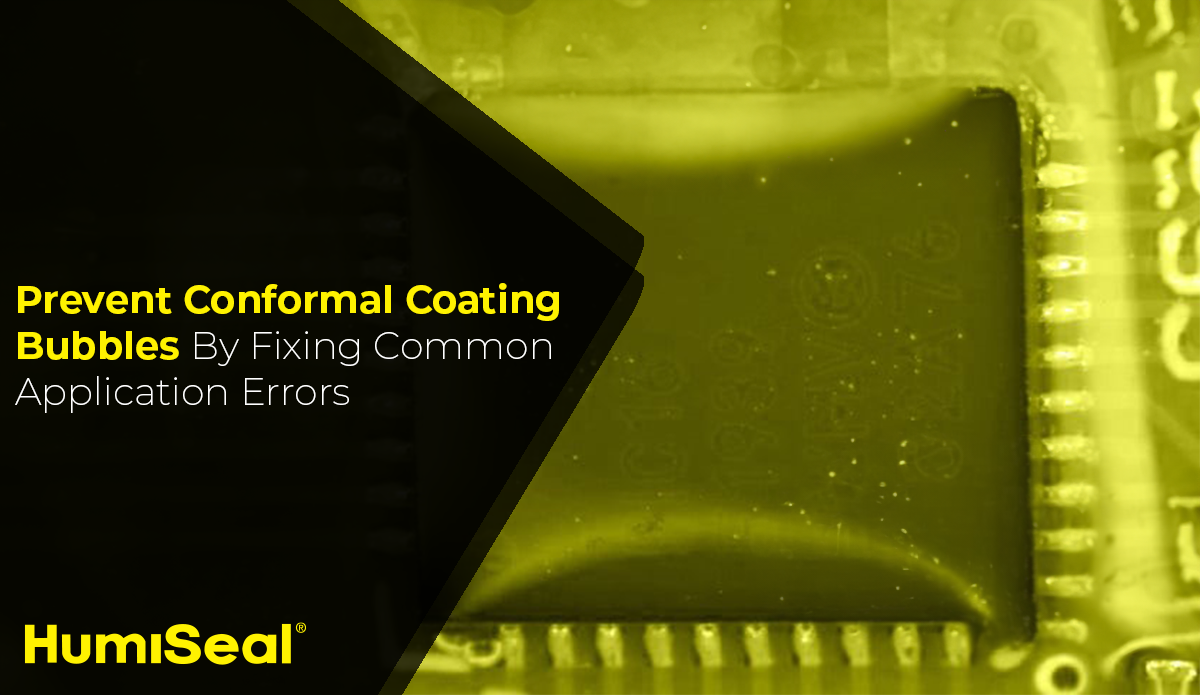
Bubbles. They can be a real challenge in any adhesive or coating, but they are particularly undesirable when covering electronics and printed circuit boards (PCBs) with fluid conformal coating material. The technical support engineers at Humiseal have over five decades of experience in support of PCB manufacturers. They report that bubbles within the finished film are the most commonly reported technical issue they receive.
In this brief article, we will discuss many of the causes as well as many potential solutions to the problem of entrapped bubbles.
3 Reasons Why Bubbles Are Problems for Conformal Coatings
OK, so before we get too far along it is probably important to know why bubbles entrapped in a conformal coating are a bad thing. There are a few answers to this, including:
- Inconsistent coating can lead to inconsistent protection
- Bubbles bridging components or leads can cause electrical failures
- Bubbles may contain corrosive or incompatible gases
 (Above: Bubble Bridging Leads)
(Above: Bubble Bridging Leads)
Of the three main issues related to bubbles, the most common and harmful tends to be the bridging of components or leads with air or gases. If a gas bubble is large enough to actually connect or “bridge” the gap between components or leads, that means that the area between those materials is unprotected and also subject to arcing or corrosion.
In older designs with less tightly populated PCB surfaces and larger leads, small bubbles were less likely to be large enough to bridge the gaps. As everyone knows, everything is getting smaller and more tightly packed with the result that the standard for the largest acceptable bubble diameter continues to shrink and get more demanding.
4 Main Causes of Bubbles in Conformal Coatings
There are only a small number of possible causes for entrapped bubbles within a conformal coating. These include:
- Air or gas entrapment within the pressure tank
- Air or gas introduced within the spray valve
- Solvent gases entrapped during the drying process
- Outgassing of curing products entrapped during drying/curing process
Let’s quickly discuss a little of the details regarding each of these causes.
The first potential source for entrapped air or gases occurs when pressure within the coating tank presses small amounts of air into the liquid coating before it enters the transfer lines to the machinery. It is often the first place to check.
How do you know if the air is mixed with the coating? This is hard to detect at first sight. If you open the pot, you will see a clean and bubble-free liquid. Using a stainless steel spatula or a viscosity cup gently stir the coating. If the coating contains dissolved air, disturbing the liquid will generate small bubbles.
Going in order, the second possible source of bubbles is that they are introduced by the spray valve. In this case, checking visually the wet coating immediately after spraying and before drying will make this evident as the source of your problems.
The final two possible sources are the most common, and these are entrapped air or gases from either the drying or curing process. If there are no bubbles immediately after spraying, but there are bubbles after drying or curing this is of course the source of the bubbles. In each case, the cause is a “skinning” or premature drying of the coating surface which then entraps either carrier solvents or the products of a chemical curing reaction (such as CO2 in the case of urethanes and some UVs).
Fixing the Root Causes of Conformal Coating Bubbles
We are now in a position to discuss the most important part; what can be done with either product or process to avoid or eliminate bubbles?
Bubbles formed in the pressure tank
The procedure to eliminate bubbles entrapped within the pressure tank is usually quite simple. Bubbles are generally entrapped due to an excessive amount of air or gas pressure when pushing the material through the lines to the coating valve. The obvious solution is to lower the air or gas pressure to the absolute minimum required, allowing an adequate flow rate to the machinery. In addition, it can be of help to keep the tank as full as reasonable at all times.
If even the lowest required pressure still introduces bubbles, it may be necessary to look at shortening the length of transfer lines and distance between the tank and machine as much as possible. It is also possible to increase the diameter of the transfer lines or raise the height of the tank to facilitate flow at the lowest pressure possible. Finally, when not in use, do not leave the pot pressurized for more than 12 hrs. Simply release the excess gas from the pressure pot to avoid future complications.
Bubbles formed immediately after atomized spray
Similar to bubbles formed in the tank, bubbles immediately after spraying are usually the result of excessive air pressures on the spray valve and atomization collar. As with tank bubble issues, the obvious solution is to lower air pressures to the lowest possible levels that still achieve adequate flow and spray pattern characteristics.
Bubbles formed during and after drying and curing ovens
As discussed earlier, bubbles formed during drying and curing are by far the most common. They are often formed due to the very top surface of the coating drying too quickly and forming a “skin” that does not allow bubbles of entrapped solvent or curing products to escape. The solutions to this problem mainly involve different methods to slow down the drying and curing process by minimizing temperature and airflow exposure early in the drying process.
There are many potential solutions:
- Lower temperatures of early oven zones
- Lower airflow in early oven zones
- Use additional thinner in the coating blend
- Use slower evaporating alternative solvent thinners
- Use lower surface tension formulations and thinners
As a supplier of all major forms and chemistries of conformal coatings, Chase Corporation and HumiSeal® can help you with an unbiased approach to evaluating your application and process. We’ll show you how to maximize efficiency, minimize cost, and improve product reliability. Our outstanding manufacturing and technical support groups can provide your organization with reliable global supply, unmatched quality, and superior technical support.
Please contact us today for a customized solution to your electronics coatings needs.








